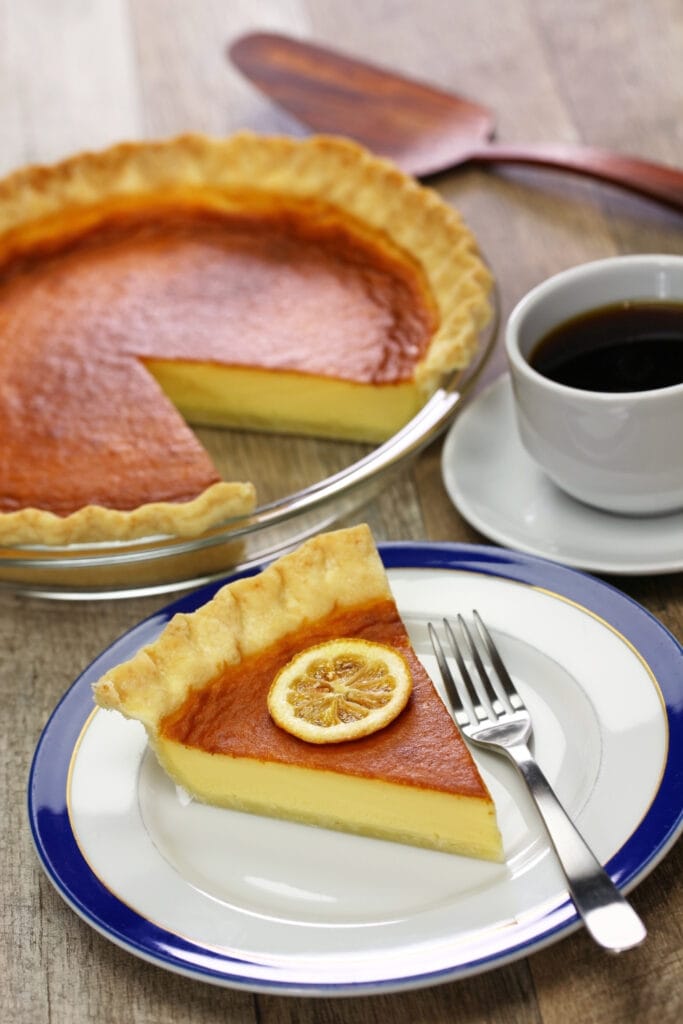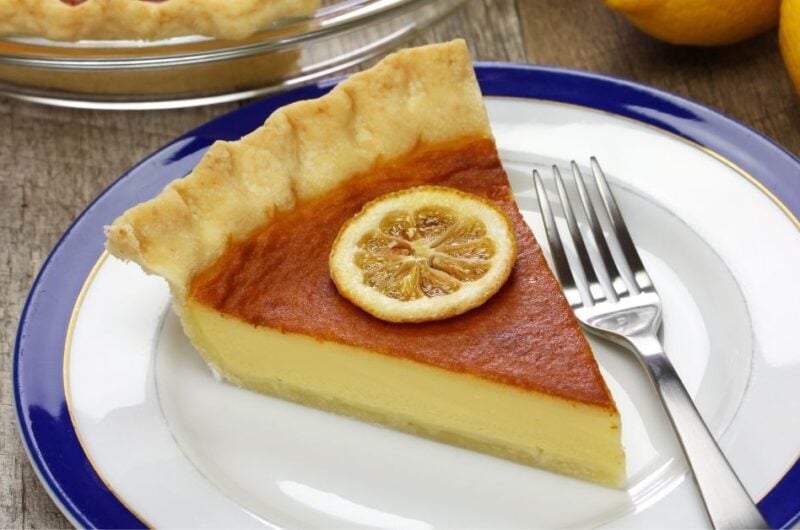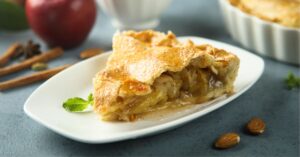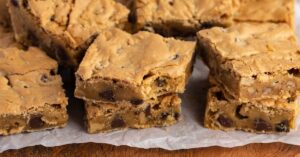Silky smooth, creamy, irresistible – you can’t beat an old-fashioned buttermilk pie.
Made with a custardy filling and a buttery pie crust, it’s always a party-pleaser, often enjoyed on holidays or special occasions.

It’s easy to see why buttermilk pie is so popular. This creamy comfort food tastes a bit like creme brulee with its rich, gooey center and crackly sugar top.
Old-Fashioned Buttermilk Pie
Buttermilk pie may be a classic southern dessert, but it’s actually an English import.
Made popular by colonial settlers, the delicious dessert was readily adopted in the southern states, where buttermilk was already a staple ingredient for home cooks.
Even today, buttermilk pie remains a time-honored favorite. If you have southern grandparents, I’ll bet they have a buttermilk pie recipe stashed away somewhere!
But there’s no need to go rifling through the cupboards.
Here’s a recipe for old-fashioned buttermilk pie that’s just as good as your granny’s version.
What Are the Ingredients for a Buttermilk Pie?
The ingredients for buttermilk pie are fairly straightforward, and you can mix everything together in one bowl.
Less time washing up means more time to eat pie!
If you’ve ever made custard, you know it can be a bit fussy.
There’s no need to bother tempering your egg yolks or heating your milk with this easy recipe. Just whisk everything together and bake.
For this hassle-free recipe, you’ll need:
- Butter – Take your butter out of the fridge before prepping this recipe. Softened butter is much easier to work with and will ensure your filling comes together smoothly.
- White sugar – This gives your custard filling its signature sweetness. Blend it well with the butter to form a creamy, smooth mix.
- All-purpose flour – Flour is the secret ingredient that keeps the custard filling perfectly thick and firm.
- Eggs – Eggs provide rich flavor and depth to the custard center.
- Buttermilk – Buttermilk is the fermented liquid left over when butter is churned into cream. Tangy and slightly sour, buttermilk punches up the flavor in this pie.
- Vanilla – A hint of vanilla extract adds a nice touch of subtle flavor to the custard filling.
- Nutmeg – A classic fall flavoring, ground nutmeg provides just the right amount of spice.
- Pie crust – No buttermilk pie is complete without a buttery, flaky crust.
Tips for the Best Pie
It’s always a good idea to get your ingredients together before you start your pie prep, and be sure they’re all at room temperature.
This helps them blend together more smoothly (and with less elbow grease on your part.)
A few other top tips for the perfect pie include:
- Make your own pie crust if you have the time. Store-bought is great in a pinch, but it’s hard to beat homemade. Whichever you use, don’t forget to blind bake! This is when you put the crust in the oven for a few minutes to bake without the filling. This keeps it from getting soggy during cooking.
- Make your own buttermilk. If you’re wondering what is buttermilk or you just don’t want to buy a big carton for one recipe, just make your own. It’s easier than you think. All you’ll need is whole milk and either lemon juice or white vinegar. Simply stir a tablespoon of vinegar or lemon into a cup of milk and let it sit for 5 minutes.
- Custard pies tend to shrink and crack after baking. It won’t alter the taste but can be really annoying if you want your pie to look its best. Help prevent unsightly cracks by letting your pie cool gradually. Try turning off the oven but leaving the pie in there with the door slightly ajar. After 20-30 minutes you can remove your smooth, unbroken pie.
- Let it rest. This pie is at its best after a few hours in the fridge. Letting it chill out allows the flavors to deepen and the filling to firm up. So give yourself plenty of time if you’re making it for a party.
- If your pie is taking longer than expected, consider putting foil over the crust to stop it burning as the center bakes.
- Serve your old-fashioned buttermilk pie with a hearty dollop of whipped cream. It also works really well with fresh berries, adding a light touch to the rich pie.

Why is my Buttermilk Pie Runny?
When you’re dealing with custard, things can get gooey. And not always in a good way.
There’s a few reasons why your pie might turn out runny, and knowing these ahead of time will avert any dessert disasters.
Here’s a few suggestions to help you avoid runny, messy pie:
- Be sure it cooks long enough. You can’t get impatient with this pie. It needs a full hour in the oven. If you’ve given it that time and it’s still too jiggly, don’t be afraid to put it back in.
- Don’t slice it too soon. The pie will continue to thicken and firm as it cools, so the longer you can wait the better. To make sure it’s fully set, put it in the fridge to chill before slicing.
- Blend your ingredients well. The trick to any custard pie is thorough whisking. If it’s going to cook evenly, you need a velvety smooth filling with zero lumps.
What Is the Difference Between a Chess Pie and a Buttermilk Pie?
While buttermilk pie and chess pie are both technically custard pies, there are a few important differences:
- As the name suggests, buttermilk pie uses buttermilk. Chess pie skips this ingredient, relying instead on evaporated milk for the creamy filling.
- The filling in buttermilk pie is thickened with flour, while chess pie uses cornmeal to firm up the custardy center.
- Buttermilk pie has a slightly different flavor to chess pie. Thanks to the buttermilk, it has a subtle tangy taste.
More Easy Pie Recipes to Try
Dream Whip Pie
Millionaire Pie
No-Bake Peanut Butter Pie











